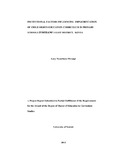| dc.description.abstract | The purpose of the study was to investigate the institutional factors influencing the
implementation of child rights education curriculum in primary schools in Murang‟a East
District. The study sought to determine the influence of the teacher qualification on the
implementation of child rights education, establish the extent to which instructional
methods influence implementation of child rights education, establish the influence of
evaluation methods on the implementation of child rights education, determine the
teachers‟ attitudes on the integration and infusion approach used in relation to the
implementation of child rights education and finally to determine the learners‟ attitudes on
the integration and infusion approach used in relation to the implementation of child rights
education. The study adopted descriptive survey design where the target population was
51 primary school 51 head teachers, 536 teachers of social studies, 2,823 pupils
comprising only the class seven pupils in public primary schools in Murang‟a East District
and District Quality Assurance and Standards Officer (DQASO). Simple random sampling
was used to select the sample which comprised 284 respondents. Data were collected
using questionnaire and interview. The response rate was 270 out of 285 respondents
making 94.7%.Interview guide was administered to District Quality Assurance and
Standard Officer. The study therefore generated both qualitative and quantitative data. For
the quantitative data, analysis of the data was done through descriptive statistics by use of
frequencies and percentages. The qualitative data was organized into themes
corresponding to the study objectives. The findings from the study showed that though
quite a number of head teachers and teachers had been trained to implement child rights
education there was still an alarming number of those who had not received any training to
implement the same and therefore this becomes a hindrance to implementation of child
rights education curriculum. From the findings, evaluation was hampered by the
absenteeism of the learners and also due to large classes as a result of understaffing in the
district. Majority of teachers over used some of the teaching methods and ignored the
others thus hindering the implementation of child rights education. In some schools,
teachers did not use participatory methods of instruction hence placing learners in the
passive role and therefore not fostering effective learning. About the attitude of both the
learners and teachers the study found out that though majority of the teachers and learners
had positive attitude toward the integration and infusion of children‟s rights in the
curriculum, there was still a number of teacher and pupil respondents who had negative
attitude toward the same thus hindering implementation of the child rights curriculum. The
study recommends the following; The Ministry of Education to carry out refresher training
for both the head teachers and teachers in order to help them keep abreast with
expectations for desirable child rights education. The Ministry of Education to sensitize
teachers to incorporate variety of teaching methods in a lesson to cater for different
categories of learners with different abilities.The government through the Ministry of
Education to employ more teachers to improve the ratio of teacher to pupils as this has an
impact on the mode of assessment and methodologies used by teachers. The school
committee and the teachers to combine efforts and generate ways of making the subject of
child rights education more enjoyable to learners. The researcher suggested for a similar
study to be done in privately owned primary schools and other public schools in rural
settings to compare the findings. Similar study to be done in public primary schools on the
children with special needs, now that there is a policy on inclusive education. | en_US |

